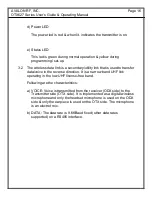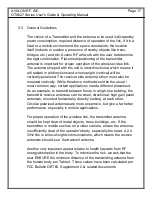
AVALON RF, INC.
Page 17
OTX627 Series User’s Guide & Operating Manual
3.3 General Guidelines
The choice of a Transmitter and the Antenna to be used is dictated by
power consumption, required distance of operation of the link, if it is a
fixed or a mobile environment, the space constraints, the location
itself (indoors or outdoors, presence of nearby objects like trees,
bridges, etc.) and etc. Avalon RF will work with the user to determine
the right combination. Placement/positioning of the transmitter
antenna is important for proper operation of the wireless video link.
The antenna shipped with the unit is omni-directional, which means it
will radiate in all directions and when upright (vertical) will be
vertically polarized. The receiver side antenna’s then must also be
mounted vertically. While the above method would be the usual /
most common way, certain applications need a different placement.
As an example, to transmit between floors in a high-rise building, the
transmit & receive antennas can be small, directional, high gain panel
antennas, mounted horizontally, directly ‘looking’ at each other.
Circular polarized antennas are more expensive, but give a far better
performance, especially in mobile applications.
For proper operation of the wireless link, the transmitter antenna
should be kept clear of metal objects, trees, buildings, etc. If the
transmitter is mobile such as on a video camera, ensure the antenna
is sufficiently clear of the operator’s body, especially the head. A 2.4
GHz link is a line-of-sight communications, which means the receive
antennas should ‘see’ the transmit antenna.
Another very important aspect relates to health hazards from RF
energy absorption in the body. To minimize the risk, we ask that the
user ENSURE the minimum distance of the transmitting antenna from
the human body per Table 4. These values have been calculated per
FCC Bulletin OET65, Supplement C & related documents.

















